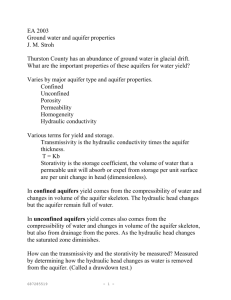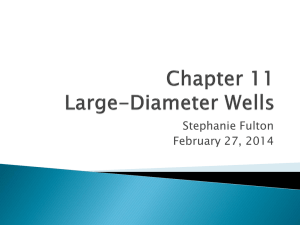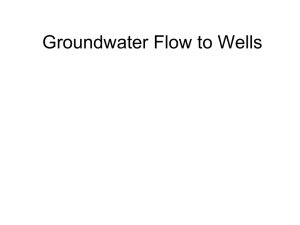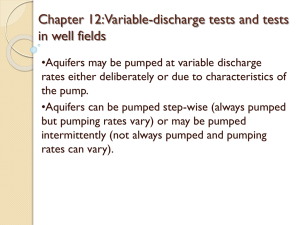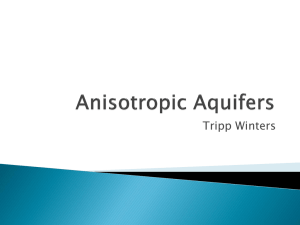Chapter 1 - Clemson University
advertisement
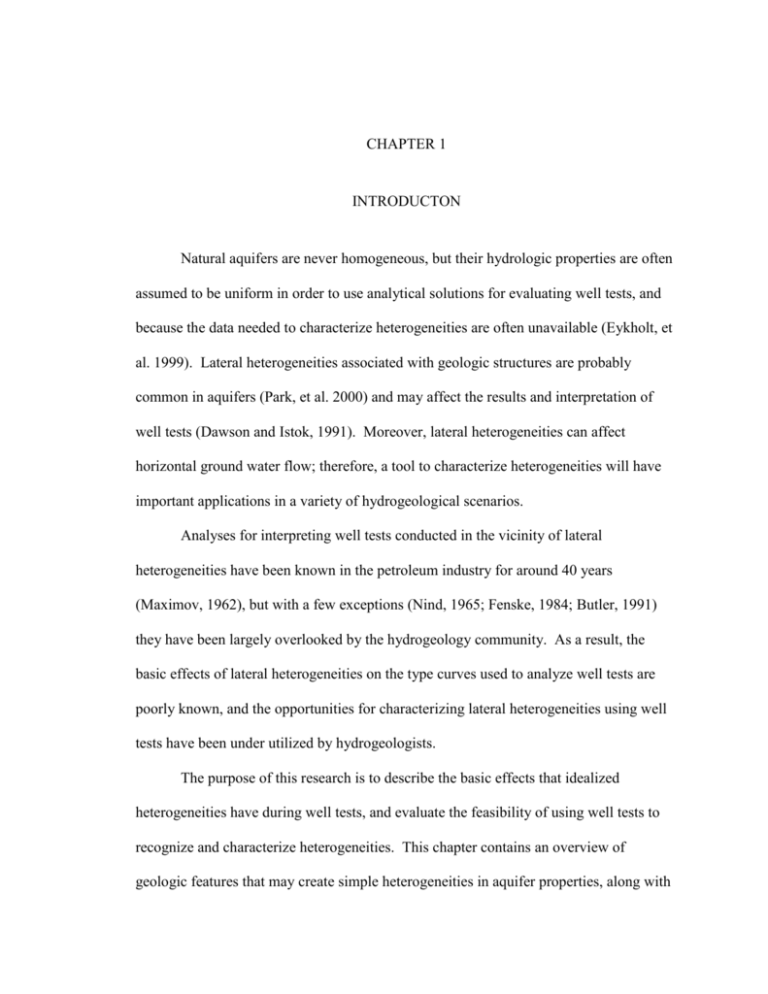
CHAPTER 1 INTRODUCTON Natural aquifers are never homogeneous, but their hydrologic properties are often assumed to be uniform in order to use analytical solutions for evaluating well tests, and because the data needed to characterize heterogeneities are often unavailable (Eykholt, et al. 1999). Lateral heterogeneities associated with geologic structures are probably common in aquifers (Park, et al. 2000) and may affect the results and interpretation of well tests (Dawson and Istok, 1991). Moreover, lateral heterogeneities can affect horizontal ground water flow; therefore, a tool to characterize heterogeneities will have important applications in a variety of hydrogeological scenarios. Analyses for interpreting well tests conducted in the vicinity of lateral heterogeneities have been known in the petroleum industry for around 40 years (Maximov, 1962), but with a few exceptions (Nind, 1965; Fenske, 1984; Butler, 1991) they have been largely overlooked by the hydrogeology community. As a result, the basic effects of lateral heterogeneities on the type curves used to analyze well tests are poorly known, and the opportunities for characterizing lateral heterogeneities using well tests have been under utilized by hydrogeologists. The purpose of this research is to describe the basic effects that idealized heterogeneities have during well tests, and evaluate the feasibility of using well tests to recognize and characterize heterogeneities. This chapter contains an overview of geologic features that may create simple heterogeneities in aquifer properties, along with a review of analyses of well tests that include the effects of heterogeneities. The objectives and approach of this investigation are also described in more detail in the following pages. Geologic Examples of Idealized Heterogeneities Geologic features that can produce lateral heterogeneities in aquifers include faults, steeply dipping beds, facies changes, and igneous intrusions. Certainly these features may span a diverse range of forms, but in many cases they can be characterized by vertical, planar contacts separating aquifer properties. Some features may resemble a single vertical contact, where one aquifer material is juxtaposed against another. Other features more closely resemble a vertical strip of one material embedded in another aquifer material that is aerially extensive. As a result, many geologic features that are complex in detail can probably be approximated using one of two idealized forms: A Two Domain heterogeneity consists of two aquifer materials of different properties separated by a vertical, planar contact. A Vertical Strip heterogeneity consists of a vertical band of one aquifer material embedded in another material with different properties where two vertical, planar contacts bound the vertical strip. Faults in rock or unconsolidated material are common features that cause lateral heterogeneities in aquifers. Faults can be either barriers or conduits, and they can influence groundwater flow from the pore to the regional scale (Rojstaczer, 1987). Two different lithologies can be juxtaposed by displacement along a fault (Fig. 1.1a). Vertical 2 a b Figure 1.1 Faulting producing heterogeneities. a) Juxtaposition of two aquifer materials such as sand and clay creating a lateral change in hydraulic properties. b) Damage zone created during faulting producing a strip with different hydraulic properties than the aquifer. 3 displacements along faults can juxtapose flat lying beds, and strike-slip displacements can juxtapose dipping beds of differing hydrologic properties. The faulting process itself may change the hydrologic properties of a formation. Vertical displacement through an assemblage of flat-lying beds may trap fine-grained sediments in the fault plane and smear them across coarse-grained units (Antonellini and Aydin, 1994; Yielding, 1997). By trapping clay, the permeability of the fault may be less than the adjacent formations. This effect can also occur in sedimentary rocks where interbedded shales can be smeared along the fault by drag folds (Yielding, 1997). Deformation associated with faulting may either reduce or increase permeability over a finite band. Faults that cut sand can cause cataclasis, where the sand grains are crushed to produce a material of fine, angular grains that can be tightly packed (Antonellini and Aydin, 1994), and thus lowering the permeability with respect to the surrounding material (Yielding, 1997). As a result of grain-size reduction, the porethroat radii are reduced and cause the permeability and porosity of the fault rock to be less than that of the matrix (Engelder, 1974). Cataclasis is the dominant process of porosity and permeability reduction in siliciclastic rock (Engelder, 1974) Faults that cut crystalline rock or well-cemented sands are commonly characterized by a damage zone that is bounded by a planar contact on either side of the fault zone (Fig. 1.1b). Open, permeable fractures may develop where there is minor displacement because of less opportunity for gouge to form between the moving surfaces. This will give the fault zone a high porosity and permeability and thus serve as a conduit for groundwater movement. 4 Steeply dipping beds can also create lateral heterogeneities in areas where significant folds or ramp faulting has occurred. Two thick, steeply dipping formations may create a lateral change in aquifer properties at their contact (Fig. 1.2a). This creates two aquifers laterally adjacent to each other. Permeable sands between thick shale units, or shale layer between sandstone will create long, strip-like features (Fig. 1.2b). Facies changes can produce large, lateral variations in the hydraulic properties of sedimentary units. For example, carbonate reef facies that grade laterally into marine clay may result in noticeable changes in hydraulic conductivity (Fig. 1.3a). Material deposited as a karst limestone reef facies can be highly permeable, 10-4 to 102 cm/s (Freeze and Cherry, 1979), due to primary porosity or fractures and dissolution features. In contrast, the permeability of marine clay is many orders of magnitude less, 10-11 to 10-7 cm/s (Freeze and Cherry). In a terrestrial setting, permeable channel sands embedded in fine-grained floodplain deposits can also form lateral heterogeneities (Fig. 1.3b). Deposits of channel sand typically resemble the river channel in which they were deposited. They are a long permeable strip bounded on either side be lower permeability material. In some locations, the sandy strip resembles the meanders of a river, whereas in other locations the channels form a broad band of sand flanked by fine-grained sediments (Sharp, 1988). Areas underlain by igneous rocks may be characterized by lateral heterogeneities that result either from patterns of fractures, or from the geometry of the igneous bodies themselves. The contact between a batholith or stock and adjacent country rock could resemble a vertical, planar contact in aquifer properties (Fig. 1.4a). The contact between a salt dome and enveloping sedimentary rock would have a similar geometry. 5 a b Figure 1.2 Dipping Beds. a) Thick steeply dipping beds creating lateral heterogeneity. b) Series of steeply dipping beds creating a strip. 6 Marine Clay Reef a Floodplain CHANNEL Deposit sand b Figure 1.3 Facies changes creating lateral heterogeneities. a) Reef facies grading into marine clay creating a lateral change in hydraulic properties. b) Channel sands embedded in floodplain deposits creating a strip of differing hydraulic properties. 7 The hydraulic conductivity of shallow igneous dikes may be significantly different than their country rock. Fresh igneous rock forming a dike may create a relatively low permeable layer where it intrudes fractured basalt (Hunt et al., 1988). However, dikes may fractured and weather more rapidly than country rock. In these cases, dikes may be form bands of relatively high permeability (Fig. 1.4b). Confined aquifers may become unconfined under certain conditions, where a confining layer pinches out. The transition from a confined to an unconfined aquifer creates lateral change in storativity. Another feature that can change an aquifer from confined to unconfined is where the confining layer has been eroded, exposing the confined aquifer (Fig. 1.5). Previous Work This research builds upon a body of previous work in the hydrogeology and petroleum engineering literature. There have been several transient and steady state solutions that deal with determining the drawdown from a well test in the presence of an idealized lateral heterogeneity. The early analyses focus on the two-domain problem, and only recently have the effects of an arbitrarily located, vertical strip been evaluated. . An early analysis of a well test conducted near a two-domain heterogeneity was published by Maximov (1962). Maximov’s paper is in Russian, but was translated for this research by Alla Khramtsova at Clemson University. Maximov treats the aquifers as thin, two-dimensional sheets. He uses Laplace and Fourier transforms to reduce the two-dimensional, transient problem to a onedimensional ordinary differential equation that can be solved exactly. He describes an 8 Batholith Country rock a Dike b Figure 1.4 Igneous rock intrusion producing lateral heterogeneities. a) Batholith intrusion into country rock creating lateral change in hydraulic properties. b) Dike intrusion into country rock producing a strip with different hydraulic properties than the country rock. 9 Confined Aquifer Figure 1.5 Unconfined Aquifer Confined aquifer changing laterally to unconfined due to pinching out or erosion of the confining layer. 10 analytical inversion of the Fourier and Laplace transforms to derive a closed-form, approximate expression for the hydraulic heads in the two domains. I conducted a numerical analysis to verify Maximov’s analytical solution. The results where contoured to evaluate the drawdown across the contact; however, the analytical solution was unable to maintain continuity at the boundary between the two regions. Streltsova (1988) applied the solution described by Maximov to determine the drawdown at a well near a two-domain heterogeneity. She also evaluates the drawdown at a well for multiple discontinuities such as two boundaries (no-flow or constant head) intersecting at right angles, 45-degree angles, a closed square, a circle, and two parallel boundaries of infinite length with the well between the contacts. A similar approach was used by Bixel et al. (1963) whose solution utilizes the diffusion equation to approximate the pressure behavior of compressible fluids. The solution was developed using a Laplace transform and the exponential Fourier transform in y. Bixel et al. present explicit expressions for the transform of the solution, but they are in the form of integrals that are cumbersome to evaluate. Therefore, the diffusivity on either side of the contact were set equal to each other to simplify the integrals and invert the solution analytically. This solution is limited to the drawdown on the same side of the contact as the well, and in some cases, only on a line perpendicular to the contact and in the pumping well region. This differs from Maximov’s solution in that Bixel et al. only evaluates the drawdown field in the pumping well region whereas Maximov characterizes the drawdown in both regions. Bixel et al. noted that early portions of the drawdown curve 11 were independent of the contact. They also points out that long pumping periods areneeded in order to characterize the drawdown field in the pumping well region in the vicinity of a two-domain heterogeneity. Another solution, predicts the drawdown in two aquifers separated by a planar contact for both the steady state and transient cases (Nind, 1965). This solution is performed using the method of images. The analytical solution accurately predicts the drawdown in the aquifer domains, provided the diffusivity (transmissivity divided by storativity) for each domain is equal. Nind noted that if the radial distance between the observation point and real well were nearly the same as the radial distance between the observation point and the image well, there is only a semi-log straight-line at late times. He also noted that observations made in the region across the contact were similar to those made from an observation point near the contact and that the presence of the heterogeneity is not reflected in the results of the well test. An analytical solution for a transient case of an arbitrary diffusivity ratio was developed by Fenske (1984) to determine the drawdown at any location where two aquifers are separated by a vertical contact. This solution applies the method of images to the transient solution for hydraulic head in two confined, homogeneous aquifers separated by a planar contact. The solution for hydraulic head in an aquifer with a lateral change in hydraulic properties requires that three conditions be satisfied at the contact. The drawdown at the contact between the two aquifers must be equal on both sides. The discharge from one aquifer across the discontinuity must be equal to the recharge into the second aquifer, and the tangent law of refraction of equipotential lines must also be obeyed. 12 A general analysis that considers the effects of a vertical strip of arbitrary location was described by Butler and Liu (1991). The Dirac delta function is used to represent the source term for the pumping well (Butler and Liu, 1991). This solution determines the hydraulic head in the strip as well as the surrounding matrix for differences in diffusivity ratios. The solution is semi-analytical with the inversion of the Laplace and Fourier transform done numerically. The semi-analytical solution allows for the pumping well to be located on either side of the strip or within the strip itself. Objectives There are three main objectives of this research. One objective is to characterize how well tests are affected by geologic features that can be idealized as either a twodomain or a vertical strip heterogeneity. Another objective is to determine how idealized lateral heterogeneities affect the interpretation of apparent properties of the formation. The third objective is to develop a method for estimating the hydraulic properties of idealized heterogeneities and test it using a field example. Approach The objectives will be met by describing drawdown fields in the vicinity of idealized heterogeneities, and by describing type cures for these scenarios. Those results will be interpreted using graphical methods, such as the semi-log straight-line method (Cooper and Jacob, 1947), along with methods developed during this research. The graphical methods will be used to interpret a well test conducted in the Piedmont province of South Carolina. 13 The following thesis is organized into seven chapters. Chapter 2 develops the analytical and numerical solutions used to produce the type curves and numerical well tests. Chapter 3 presents and discusses the patterns of drawdown fields produced by different types of heterogeneities. Time-drawdown type curves are presented in Chapter 4 to evaluate the affect of lateral heterogeneities. Chapter 5 presents a method for determining the hydraulic properties of idealized heterogeneities using drawdown curves. A field example is presented in Chapter 6 to test the feasibility of characterizing idealized lateral heterogeneities using time-drawdown curves. The results are summarized in Chapter 7. 14
